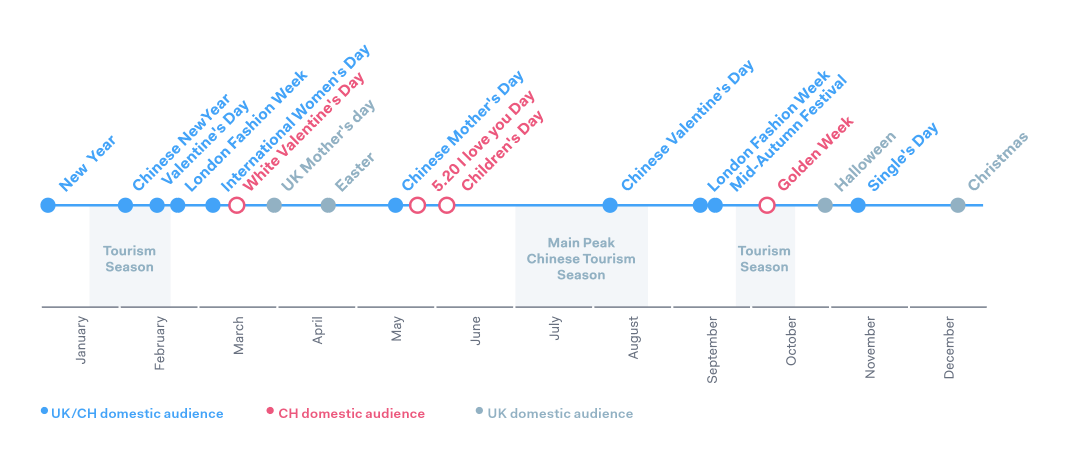Guides and reports
How to sell to Chinese shoppers in the UK
What do Chinese shoppers in the UK really want? We hit China’s popular shopping streets to find out.

Quick read:
Chinese shoppers in the UK present a huge opportunity for retailers. To help identify the best ways of selling to Chinese visitors, we went on a fact-finding mission to China. We hit the shopping streets of China and spoke directly to consumers to learn more.
We broke our findings down into the 3 Es of the buyer journey:
Entice
The buyer journey begins while the shopper is still in China. Know your demographics and how to target them.
Excite
Integrate online channels into your store experience, offer the right payment methods, and make tax-free shopping a breeze.
Engage
Make sure your brand is worth writing home about (or sharing on social), engage with Chinese travel review platforms and encourage selfies.
Download the report: Retail lessons from China now
Download China report
Get report_______________________________________
Complete read
As a retailer, you know very well the huge opportunity posed by Chinese shoppers in the UK. And it’s only going to grow. Visitor numbers are expected to increase by 40% this year to reach £1 billion in spending. And the 11% rise in wealthy Chinese students studying here is just the beginning.
This news is a welcome relief to the flagging high-streets and high-profile closures that dominate the UK headlines. And we've seen retailers make great headway in their strategy to sell to Chinese shoppers in the UK by offering Chinese payment methods in store. But this is just the starting point.
The Chinese buyer journey starts at home and continues far beyond the sale.
The Chinese buyer journey starts at home and continues far beyond the sale. Retailers need to connect their marketing and payment strategies, and make use of the marketing tools offered by Chinese payment methods to take their sales to the next level.
Our fact-finding mission to China
To understand shopping from a Chinese perspective, we teamed up with marketing consultancy Emerging Communications and tax-free experts Global Blue to set out on a fact-finding mission. We met with leading Chinese technology partners and hit the shopping streets to see what retail looks like first-hand. We hosted focus-groups for both Chinese consumers in China and Chinese students living in the UK. And we spoke to some of the top local social media influencers, known as Key Opinion Leaders (KOLs).
Here’s what we learned:
Selfies, seafood, and scoreboards: Shopping in China
We all knew that mobile and high-tech experiences dominated the Chinese retail scene. But we were still blown away when we saw it in action.
Alibaba shopping center, Hangzhou
Before you visit the Alibaba Shopping Centre in Hangzhou, you can check the official app to see how busy it is in real-time. Once there, you can scan your phone to play games or earn vouchers. You can even order live fish from tanks to be eaten on-site or delivered to your home.
K11 Art Mall, Shanghai
K11 Art Mall in Shanghai brings you ‘art museum retail’, displaying contemporary art in exhibition areas around the mall. It provides the perfect selfie backdrop, making it a popular spot for anyone with a social media presence.
MAC store, Shanghai
As you arrive at MAC’s new concept store, you’re invited to follow MAC’s WeChat account. If you agree, you’re greeted by a personal message displayed on screens. You can virtually try on different shades of cosmetics recommended by popular KOLs or those adapted to suit. In-store screens let you look up the latest user posts and reviews on the social media platform Little Red Book where you can also share your own photos.
All of these experiences seamlessly integrate the physical store with the shopper’s life online. The brands understand how their customers like to interact with them, and they know which channels to use. So, although we’re not suggesting these examples are used as a benchmark, they are a useful reference point.
To help you successfully target Chinese shoppers in the UK, we’ve broken it down into three parts, which represent the three phases of the customer journey: Entice, Excite, and Engage.

Entice
Months before visiting the UK, Chinese consumers research brands they identify with and the products they like. So communication with consumer targets must begin well in advance of departure. You need to understand your audience, their journey, and the platforms they are using.
"I feel the level of awareness is low but British brands have great quality."
"My message to UK retailers is ‘do more advertising’. It doesn’t need to be anything big. I like to see average people’s reactions and reviews to products, but I need to know the brand first. I feel the level of awareness is low but British brands have great quality." Red Meat Tonight (KOL)
In the West, we segment by groups such as Millennials or Gen X. But in China things get more granular:

Post-80s
The initiators of the Chinese consumerism movement. Aspiring trendsetters, they value quality of life, empathy, and fashion. You’ll find them on WeChat.
Post-90s
Highly opinionated online shopping generation who’ve already spent as much on luxury consumer goods as their parents. You’ll find them on WeChat.
Post-95s
These guys look for intangible experiences and meaning behind their purchases. They love social media shopping and speed is of the essence. You’ll find them on Weibo.
Post-00s
They’re still financially dependent on parents and won’t buy anything that can’t be immediately paid for. They put less stock in brand origin. You’ll find them on QQ.
The power of influence
Key Opinion Leaders (KOLs) have a huge influence on the market sectors in which they specialise and they are an established part of the marketing process in China. They often have millions of followers, making or breaking brands with their reviews. Not only can they be a vital part of the marketing process but they also have enormous insight into the consumer perspective.
"Social media is probably the most influential channel."
"Social media is probably the most influential channel. For example, young people like to spend time on Douyin (TIK TOK), and of course, everyone knows Li Jiaqi (famous lipstick KOL) and his 'OH MY GOD!' He will talk about what character or style of girl the lipstick would suit and give examples using different celebrities to make comparisons. Previously I watched one of his live streams and, as soon as it finished, I went to the store and bought two lipsticks." Focus group participant

Excite
Customer experience plays a vital role in retail success. Our latest retail report revealed that British retailers have a £100 billion opportunity to improve their shopper experience. They can do this by cutting queue times, offering the right payment methods, and addressing out-of-stock issues. When it comes to Chinese shoppers in the UK, you can take it further with the following in-store experiences:
Make it special with bespoke items
Chinese shoppers have traveled a long way and are looking for products that will stand out back home. Bespoke products are popular and are often shared on social media. Another irresistible force is product rarity.
"As soon as I see something is a limited edition or almost sold out I will buy it."
Integrate mobile
In China, the use of QR codes to make purchases is universal; codes can be found on everything from vending machines, to print and outdoor media, in-store items, and menus. Purchase decisions are made quickly and payment is taken on the spot. Chinese shoppers in the UK expect the same convenience.
Which leads us neatly on to… Chinese payment methods.
You all know the importance of supporting the Golden Triangle of Chinese payment methods: UnionPay, Alipay, and WeChat Pay.
UnionPay
The world's largest card scheme, UnionPay covers almost 80% of the payment share in China and is popular for making high-value purchases.
Alipay
With over one billion users and counting, Alipay is the leading payments and lifestyle platform for Chinese shoppers in Europe. It offers a range of free marketing tools, for example, you can send push notifications to all Alipay users within 200 meters of your store.
WeChat Pay
The social platform WeChat is so ingrained into the lives of its users that someone who loses their smartphone in China is likely to say: ‘I’ve lost my WeChat.’ It’s also an advertising channel where retailers can display brand information and communicate with shoppers. It’s committed to expanding its footprint across Europe and we’re seeing some interesting developments as it ramps up competition in the region.
Make it tax-free
Western goods are heavily taxed in China, so it makes sense for Chinese shoppers in the UK to stock-up. Tax-free shopping company Global Blue has teamed up with UnionPay, Alipay, and WeChat Pay to make tax reclaims quick and easy. In supported stores, Chinese shoppers can even receive tax refunds directly to their UnionPay, Alipay, or WeChat Pay accounts. This puts cash back into the shopper’s hands - allowing them to spend more.
Engage
If you know when and how to target your customers you’ll continue selling to them when they return home.
Know your Zhihu from your Dianping
If you want Chinese shoppers to spread the word about your brand, you’ll need to become familiar with the travel review platforms. A good place to start is Ctrip. It’s an online travel agency-come-social platform where returning tourists can write reviews and share experiences. Ctrip’s latest programme, Trip Moments, encourages tourists to upload photos and videos from both inside and outside stores. Ctrip then links the photos to your official store page. Other popular review platforms are Dianping, (Chinese TripAdvisor), Zhihu (Chinese Quora), and Mafengwo (online travel agency).
Become a selfie magnet
Set up a branded backdrop in your store and encourage your shoppers to strike poses. It’s a sure-fire way of making it onto their newsfeeds.
Get your timing right
There are more than 80 calendar events in China that could be a catalyst for shopping. Think beyond summer holidays, Golden Week, and Chinese New Year and position your marketing efforts across some of the niche events that are relevant to your brand.

Learn more about selling to Chinese shoppers in the UK
This article only scratches the surface of our learnings. Download the full report: Retail lessons from China to:
- Discover what Key Opinion Leaders had to say about shopping in the UK
- See a detailed breakdown of the top Chinese social platforms
- Get more insights into delighting Chinese shoppers in the UK